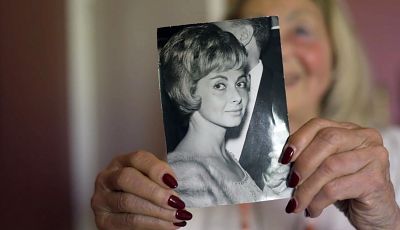
JIFF: The Bridgeplayers
Click here if you liked this article 6 ![]()
https://www.jiff.com.au/films/the-bridgeplayers
Date Reviewed: 24/10/2025
Opening words appear on screen as a quiet countdown begins:
Nearly a hundred years ago four girls were born.
They grew up surrounded by love in large Jewish families.
But when Nazism took hold in Europe everything changed.
They were forced from their homes into crowded cattle wagons and taken to Auschwitz.
Their parents and younger siblings were murdered…
But the four girls survived.
This is their story.
Directed by Bengt Bok and Alberto Herskovits, The Bridgeplayers is an understated yet deeply affecting documentary that tells the story of four remarkable women — Eva Byk, Mimmi Levy, Elisabeth Masur, and Livia Frankel — who survived Auschwitz as teenagers and later built full lives in Stockholm, Sweden.
Bound by eight decades of friendship and a shared love of bridge, they represent some of the last living witnesses to the Holocaust. What makes the film even more compelling is its timeliness: it unfolds against the backdrop of the Hamas attacks of 7th October 2023 and the ensuing war in Gaza, which stir long-buried memories and reopen wounds that never fully healed.
The film’s genius lies in its quiet observation. There are no grand statements, only gestures, fragments, and the rhythm of daily life.
The women dust their figurines, iron clothes, and sip tea in light-filled Stockholm apartments adorned with Persian rugs and family photos.
These tender domestic moments mirror the weight of memory — of trauma that has never truly receded.
In one of the film’s most moving sequences, Elisabeth Masur speaks with her granddaughter about the tragedy, something she never shared with her own daughter. Her granddaughter confides that she dreams of being chased by Nazis, a haunting reflection of how fear can travel through generations.
Bok has said in an interview that his challenge was “to make the ladies understand that their present lives were interesting to us.” And they are.
Through bridge games, conversations, and silences, the film reveals how the Holocaust’s aftershocks reverberate through the mundane.
Trauma is not just recalled, it is lived with, embedded in gestures, in what is left unsaid. Midway through the film, the narrative shifts. As the news of 7 October and the Gaza conflict breaks, the women, now nearing a hundred, watch in disbelief. The streets of Stockholm grow eerily quiet; Israeli flags wave on Eva’s visit to Tel Aviv; and their phones buzz with messages from worried grandchildren. Eva admits, “I haven’t been myself since the 7th of October… I’d rather not remember, but the thoughts come.”
Mimmi listens to the radio, silent as she hears of rockets over Israel.
Elisabeth says simply, “Auschwitz hasn’t let go of me. I always carry it with me.”
The Holocaust and the current Middle East conflict exist as twin mirrors, reflecting fear, displacement, and the ache of survival. For these women, bridge is more than a game.
“If I’m feeling stressed, I play bridge,” Mimmi says. “It doesn’t cost anything, and there’s no guarantee you’ll live to retirement, so you may as well start now.”
Bridge playing is a metaphor for endurance, a structure, a logic, a shared space where memory can breathe. Their laughter is subdued, their focus intense. The card table becomes a sanctuary, the one place where chaos yields to order. Each of the women reflects differently.
Eva visits her father’s grave in Israel, whispering, “We’ll be meeting soon.”
Elisabeth shows her granddaughter a photo of her little sister, killed at seven, and admits she had her Auschwitz tattoo removed out of shame.
Livia recalls her first return to Germany in 1961, lying awake, unable to stop crying at the sound of the language.
And Mimmi, fierce and witty at 96, declares that her revenge on Hitler is her family: “Luck is worth more than beauty.”
Through them, The Bridgeplayers becomes not only a meditation on memory but a dialogue between generations.
The film is visually unassuming, clean Swedish interiors against wintry exteriors, yet every frame is deliberate.
Alberto Herskovits’ cinematography lingers on chandeliers, combs, brushes, and old photographs.
These objects, like the women themselves, are fragile yet enduring.
The original score, performed with violin, cello, oboe d’amore, and bass drum, is sparse and Brecht-like, never sentimental. It lets silence speak.
In the end, The Bridgeplayers does not seek to shock or instruct. It invites us into the stillness of late life, where reflection replaces testimony. When Mimmi recalls her first visit to Israel, she says: “No one could call me a ‘fucking Jew’ there. They could call me a ‘fucking whore,’ but never that.” Her wordsland with both heartbreak and defiance. This is survival distilled to its essence: the will to live, to play cards, to keep beauty and order alive amid chaos.
A quiet masterpiece of restraint and humanity, The Bridgeplayers reminds us that history is not a sealed chapter but a living pulse.
It is a film about memory; not how it fades, but how it persists in gestures, silences, and the delicate art of carrying on.
Highlights
- The unique and intimate perspective of the Holocaust and events of 7th October 2023.
- The intergenerational echoes of the women and their families.
- The use of Bridge as a metaphor for survival.
- The sparse Brecht-like score by Johann Arrias and sound by Bengt Bok and Jonas Goldman.
Who’s it for
- History and holocaust students
- Members of the Jewish community
- Anyone interested in memories and trauma
- Seniors and families due to the intergenerational aspects and focus on ageing
- Documentary film enthusiasts
‘The Bridgeplayers’ is one of 50 Jewish-themed films from around the world, screening as part of the Jewish International Film Festival in Australian cinemas nationally from 19th October through to 21st December.
Reviewed by Mary Sinanidis